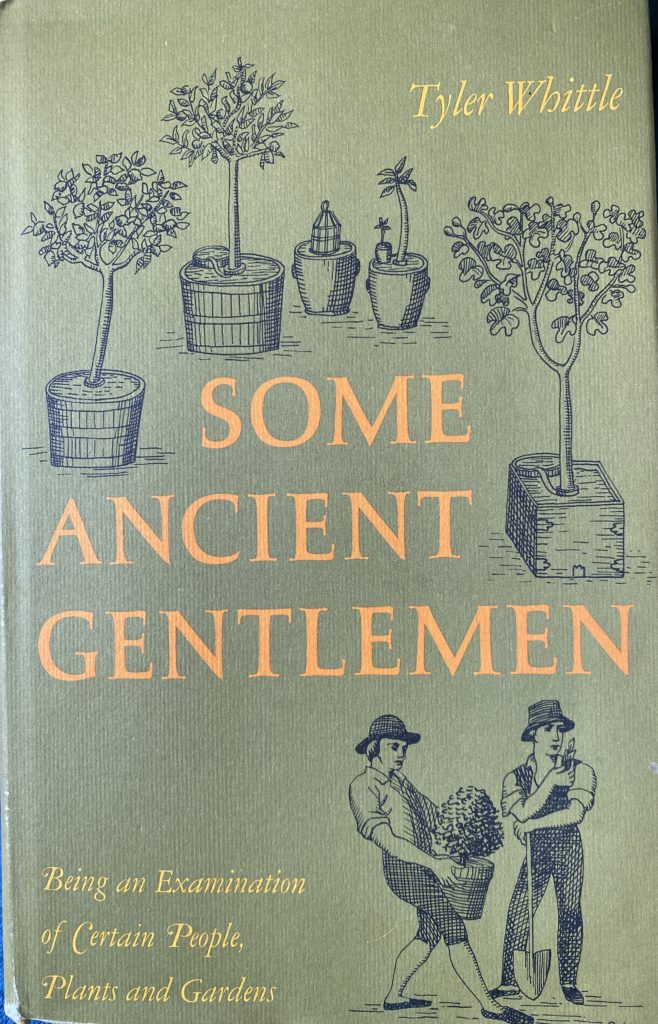
I recently started reading Some Ancient Gentlemen: Being an Examination of Certain People, Plants and Gardens by Tyler Whittle (1966, Taplinger Publishing Co., Inc. )
Ah, the good ol’ days of garden writing. I’m not saying that gardening books these days are boring. I’m just saying that reading books from 50—oh wait—56 years ago, introduces one to a style of writing that we don’t often see these days.
I could quote and quote and quote from this book but instead I’ll just hone in on the word “floracrat” of which he writes, “In one tormented afternoon I saw five species of stove climbers which, if there is such a word (and I believe there ought to be) deserved to be called floracrats.”
Floracrats. What a wonderful word! But it’s a word that doesn’t seem to have a definition or even widespread use. We must fix that!
First, I did an online search for the word, and the internet came up with a book with that word for its title, but the author uses the word to talk about certain bureaucrats and botanists, not flowers. Since that book was written a few years ago, we’ll let that author’s definition be the second definition of the word.
On to the first definition!
The sentence prior to the one I quoted above gives us our first clue as to the definition of “floracrat.” “In the temperate houses of botanic gardens, I felt precisely like Raffles regarding the Crown Jewels, or Billy Bunter outside a locked up pantry.”
Whittle, who is British, took me down a tiny rabbit hole to look up information about Raffles and Billy Bunter. What they have in common is they couldn’t get to what they wanted. Whatever it was, it was unattainable.
Unattainable! Now we can assume that floracrats are unattainable for us mere mortal gardeners, who may look but can’t touch. They are out of our reach, perhaps due to the climate we garden in, or maybe the cost, or who knows why? Floracrats are just for some reason not something we are likely to successfully grow in our own gardens.
Further on, I read, “Exotics like these have a meaty quality of beauty. They are elegant and delicate, but too voluptuous to be ‘pretty’ in the ordinary sense.”
He then lists some of these stove climbers, which is his word for vigorous, rampant climbing plants.
There’s Crab’s Eye Vine (I’ve never heard of it), Antigonon (also new to me and not hardy enough for my garden), Beaumont (also new to me and I can’t find it in a quick search), Mediterranean Angels’ Trumpets (Bignonia tweediana) (I am familiar with Bignonia) and three varieties of passion flowers (which we assume are Passiflora sp., some of which I can grow.)
What do all these flowers have in common?
Other than being lovely flowers on vines, they don’t seem to have too much in common except Whittle considered them elegant and delicate, with a meaty quality of beauty. And we would likely describe them with a more enthusiastic word than “pretty.”
So back to our definition of floracrat, here’s my best shot at it, using the clues Whittle left us in this one reference in this one book.
floracrat
flôr′ə crat
noun
- A flowering plant that is unattainable to a gardener due to climate or other limitations of their garden or life circumstances;
- A flowering plant that has an exotic look which one would describe as elegant and delicate, even meaty, definitely much more than pretty.
- A vigorous flowering vine of remarkable beauty.
flor-a′·crat′ic, flor-a’·crat′i·cal adj. flor-a′·crat′i·cal·ly adv.
Yes, I see that’s three definitions, but such a word needs all these definitions.
Some sample sentences…
She went to the local conservatory to see all the floracrats blooming profusely on a cold wintry day.
The staff at the local garden center advises new gardeners to avoid floracrats until they have more experience tending to plants.
What’s a floracrat you’d like to grow (meet) someday?


I love this definition – and your effort to peel the proverbial onion to reveal it. There are many floracrats I covet, including peonies, tulips, and Astrantia among many others. For the record, I’ve tried growing all those I just named, some multiple times, always with minimal to no success. While people periodically comment on my “exotic” plants, most are really just plants that happen to be suitable to my Mediterranean climate.
You are crazy girl.
I wish I could grow Rhododendrons. I grew up in Northern West Virginia. They were everywhere. My parents had one that would get so big.It was gorgeous! My dad had to cut it back, because it would cover a large window!
I would call my purple Passionflower a floracrat. It looks too exotic to be a Hoosier Native plant and I can grow it on a south-facing rail fence in my Walnut-infested woodland garden.